New Concept IPTSold Out!
With so many folks already signed up it is looking as if folks are liking the idea of more image review during the days, more in-the-field-instruction with a smaller group, no time in the classroom, and a bit more time to rest and sleep…. Learn more by clicking here and scrolling down to the first item.
Pro-rated
While this trip is sold out, we still have room for one more on a pro-rated basis. If you would like to explore the possibility of joining us for a day or two on this IPT or a morning on the Hooptie Deux please e-mail me asap or call me asap on my cell at 863-221-2372 or on my personal line at 863-692-2806.
Fort DeSoto/Hooptie Deux/Roseate Spoonbill Short Notice IPT: March 6-10, 2013. 5-DAY: $2399 (Includes 3 mornings on the Hooptie Deux). Limit: 6/Openings: 0.
Join me as part of a small group for five great days of bird photography and learning. We will spend three mornings with the breeding plumage spoonbills on James Shadle’s customized pontoon boat, the Hooptie Deux. This alone would cost you $1050 so this works out to the cheapest IPT ever: 5 full days for only $1349. We will spend two of our mornings and four of our afternoons at Fort DeSoto photographing all manner of wading birds, gulls, terns, and almost surely some Great Horned Owl chicks. Our last afternoon will be spent at an active Wood Stork rookery with lots of flight photography opportunities.
|
This image (Tree Swallow sharp I) was created with the tripod-mounted Canon EF 600mm f/4L IS II USM lens, the Canon 1.4x EF Extender III (Teleconverter), and the Canon EOS-1D X Digital SLR camera. ISO 500. Evaluative metering +1/3 stop: 1/1250 sec. at f/5.6 in Manual mode confirmed by histogram check. Central sensor Surround/AI Servo/Rear Focus AF active at the moment of exposure. Click here if you missed the Rear Focus Tutorial. Click on the image to see a larger version. |
When Sharp Just Does Not Cut It
There have been about 20,000 Tree Swallows down by the lake that is five minutes west of my home for the past two mornings. I had been set up for flight when the group in the images above and below blasted off so I went with a fast shutter speed knowing that I would not like the results.
|
This image (Tree Swallow Sharp II) was also created with the tripod-mounted Canon EF 600mm f/4L IS II USM lens, the Canon 1.4x EF Extender III (Teleconverter), and the Canon EOS-1D X Digital SLR camera. ISO 500. Evaluative metering +1/3 stop: 1/1250 sec. at f/5.6 in Manual mode confirmed by histogram check. Central sensor Surround/AI Servo/Rear Focus AF active at the moment of exposure. Click here if you missed the Rear Focus Tutorial. Click on the image to see a larger version. |
The Problems With Sharp
Note that in both of the images above the off-angled light is accentuated by the fast shutter speed. With the narrow depth-of-field note that the out-of-focus birds in the foreground that are in front of the plane of sharp focus are huge distractions. Note that there is no sense of implied motion. I would normally deleted both of the images above but kept them only for teaching purposes.
|
This image (Tree Swallow Flock Blur I) was also created on March 2, 2013 with the tripod-mounted Canon EF 600mm f/4L IS II USM lens, the Canon 1.4x EF Extender III (Teleconverter), and the Canon EOS-1D X Digital SLR camera. Note however that for creating a pleasingly blurred image I dropped all the way down to ISO 50. Evaluative metering +2/3 stop as framed: 1/15 sec. at f/16 in Manual mode confirmed by histogram check. (Folks who convert in DPP as I do need to disable Highlight Tone Priority to get down to ISO 50. Note also that unless you are converting in DPP that enabling Highlight Tone Priority has no effect on your RAW files. To learn more about converting in Canon Digital Photo Professional and why I am using it 100% of the time click here and here. Central sensor Surround/AI Servo/Rear Focus AF active at the moment of exposure. Click here if you missed the Rear Focus Tutorial. Click on the image to see a larger version. |
ISO 50
When creating pleasing blurs setting the lowest possible ISO allows you to work at relatively wider apertures; this reduces the amount of time that you will spend cleaning microscopic dust bunnies. There is a lot less visible sensor dust at f/16 than at f/32 or smaller.
|
This image (Tree Swallow Flock Blur II) was created with the tripod-mounted Canon EF 600mm f/4L IS II USM lens, the Canon 1.4x EF Extender III (Teleconverter), and the Canon EOS-1D X Digital SLR camera. Note however that for creating a pleasingly blurred image I dropped all the way down to SO 50. Evaluative metering +2/3 stop as framed: 1/15 sec. at f/18 in Manual mode confirmed by histogram check; note that it had gotten a shade brighter. Central sensor Surround/AI Servo/Rear Focus AF active at the moment of exposure. Click here if you missed the Rear Focus Tutorial. Click on the image to see a larger version. |
Why Pleasing Blurs? To Pan or Not to Pan?
Note the implied motion. Note that the off angled light has been softened considerably. See the pleasingly pan-blurred backgrounds. Note that the birds traveling in the direction opposite the pan were rendered as soft, white streaks.
In the image above I was panning from right to left with the main flock, the dark birds. This accentuated the streak blur on the birds flying against the pan. But I varied my approach; with the image below, I held the lens relatively still without panning. Note the the degree of blurring of the individual birds was roughly the same regardless of the direction of flight.
|
This image (Tree Swallow Flock Blur III) was created on the morning of March 3, 2013 with the tripod-mounted Canon EF 600mm f/4L IS II USM lens, the Canon 1.4x EF Extender III (Teleconverter), and the Canon EOS-1D X Digital SLR camera. Evaluative metering +2/3 stop as framed: 1/15 sec. at f/10 in Manual mode confirmed by histogram check. Lowest central sensor/AI Servo Surround/Rear Focus AF active at the moment of exposure. Click here if you missed the Rear Focus Tutorial. Click on the image to see a larger version. |
Why 1/15 sec.? Why Only f/10 For This Image?
1/15th of a second has long been the classic pleasing blur shutter speed. For good reason: it often offers a very pleasing degree of blurring. I made images on both mornings at 1/8 sec. but did not keep a single one….
On Sunday I was out in the field an hour earlier than I had been on Saturday as it was a clear morning. Saturday had started off cloudy. As there was less light on Sunday I was able to use a larger aperture than I had on Saturday while still pushing the exposure to the right and making sure to get data well into the fifth (rightmost) box of the histogram.
|
This image (Tree Swallow Flock Blur IV) was also created on Sunday morning. For this one I got lower and used the tripod-mounted Canon EF 600mm f/4L IS II USM lens, the Canon 2x EF Extender III (Teleconverter), and the Canon EOS-1D X Digital SLR camera. ISO 50. Evaluative metering at zero: 1/15 sec. at f/14 in Manual Mode was a bit under-exposed. Central sensor (by necessity) Expand/AI Servo/Rear Focus AF on flock and released the back button. Click here if you missed the Rear Focus Tutorial. Click on the image to see a larger version. You cannot beat the 600II/2XIII TC combo for reach (with phase detection AF). |
Which is Your Favorite?
Take a moment to leave a comment and let us know which is your favorite image, and why.
A Guide to Pleasing Blurs
If you would like to learn more about creating pleasingly blurred images–they are not out of focus accidents, check out A Guide to Pleasing Blurs by Denise Ippolito and yours truly.
Seriously Huge B&H Savings on Nikon and Canon Gear
Nikon
For the first time in many years NIKON is going to be deeply discounting many legacy pro lenses individually for the next 2 weeks only with discounts up to $350. There are also many amazing deals on NIKON Buy together and Save packages as well. Click here to save.
Nikon DSLRS Bundles with Lenses & Flash: Save up to $750. Click here to save. Make sure to add each item to your shopping cart to see the absolute lowest price.
Canon Lenses & Speedlites: Save Up to $300
Click here to save. Make sure to add each item to your shopping cart to see the absolute lowest price.
Canon Buy Together & Save: Save Up to $400
Click here to save.
EOS-1D X AF Guide
You can learn exactly how I set up and use this camera’s great new AF system in our EOS-1D X AF Guide. And you can learn about our other camera User’s Guides here.
Southwest Florida Site Guide
Several folks have written recently asking why this great guide has not been updated since 2007. The answer is that I have not discovered any new hotspots and that the good places remain good and the great places remain great.
Typos
On all blog posts, feel free to e-mail or leave a comment regarding any typos, wrong words, misspellings, omissions, or grammatical errors. Just be right. 🙂
Support the BAA Blog. Support the BAA Bulletins
We want and need to keep providing you with the latest free information, photography and Photoshop lessons, and all manner of related information. Show your appreciation by making your purchases immediately after clicking on any of our B&H or Amazon Affiliate links in this blog post. Remember, B&H ain’t just photography!
Shop Amazon
And from the BAA On-line Store:
LensCoats. I have a LensCoat on each of my big lenses to protect them from nicks and thus increase their re-sales value. All my big lens LensCoat stuff is in Hardwood Snow pattern.
LegCoat Tripod Leg Covers. I have four tripods active and each has a Hardwood Snow LegCoat on it to help prevent further damage to my tender shoulders :) And you will love them in mega-cold weather....
Gizo GT3532 LS CF Tripod. This one replaces the GT3530LS Tripod and will last you a lifetime. Learn more about this great tripod here.
Mongoose M3.6 Tripod Head. Right now this is the best tripod head around for use with lenses that weigh less than 9 pounds. For heavier lenses, check out the Wimberley V2 head.
Double Bubble Level. You will find one in my camera's hot shoe whenever I am not using flash.
The Lens Align Mark II. I use the Lens Align Mark II pretty much religiously to micro-adjust all of my gear an average of once a month and always before a major trip. Enjoy our free comprehensive tutorial here.
BreezeBrowser. I do not see how any digital photographer can exist without this program.
Delkin Flash Cards. I use and depend on Delkin compact Flash Cards and card readers most every day. Learn more about their great 700X and 1000X cards here or about my favorite Delkin card here.

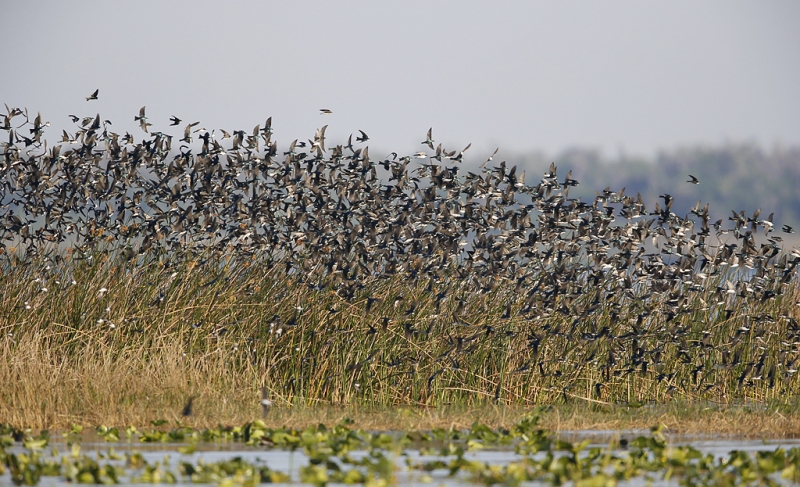
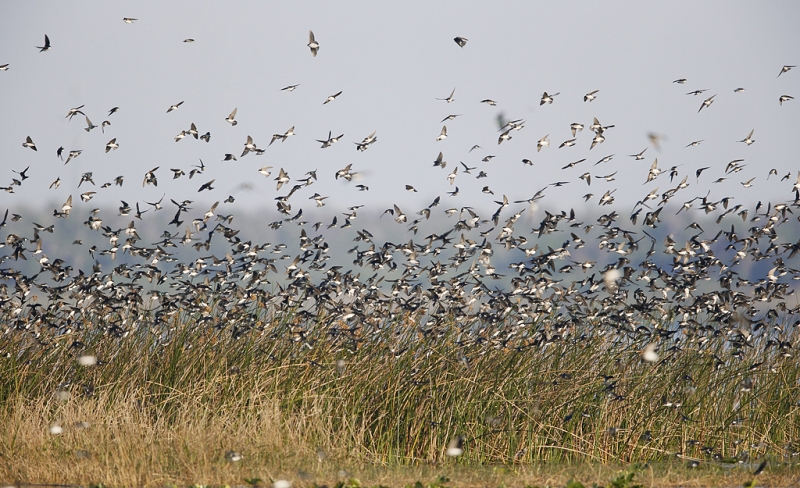
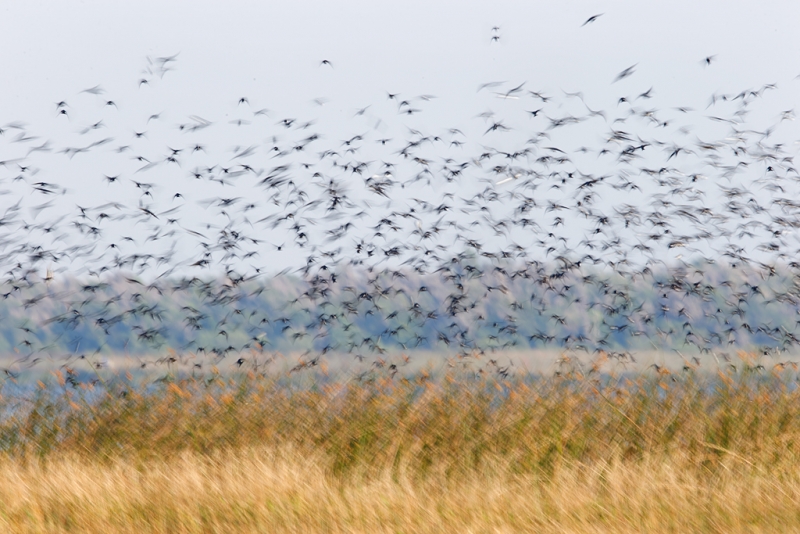
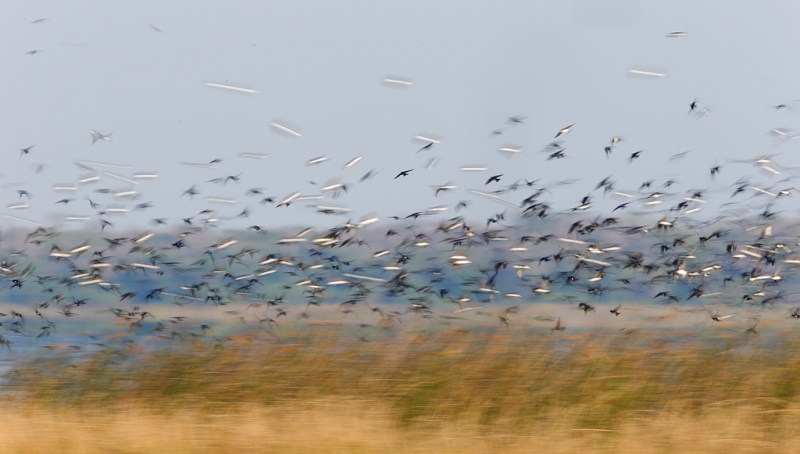
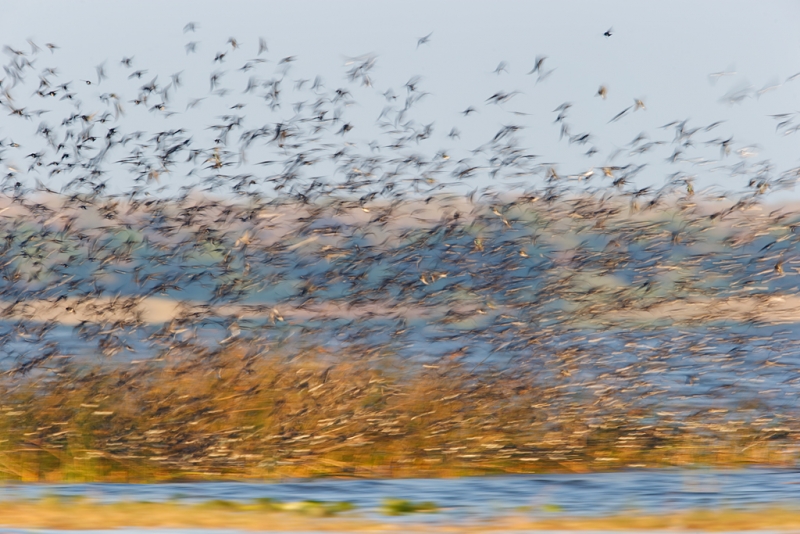
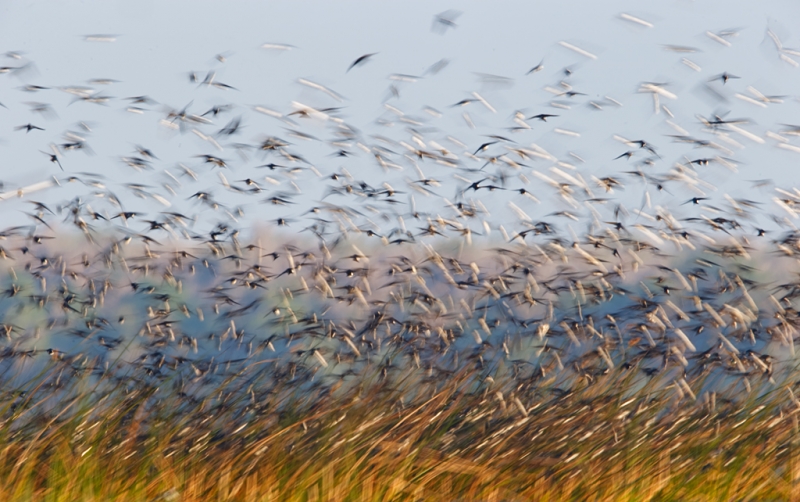













Thank you for the wonderful breakdown of these blurs. There is such a fine line between a pleasing blur and one that is headache inducing. My favorite is Blur IV as I love flow up the lines formed by the grass and into the movement of the birds. It almost has a golden spiral feel to it.
Wow, these blastoffs resemble the great blastoffs at Bosque, only with smaller birds. I, like Doug, prefer Blur IV. It has a beauty of symmetry to it…with the grasses blending (contrasting with?) the flow of the flock of birds. Gorgeous, and I would like to have this one framed on a wall.
Hi Artie, my favourite is Blur I because I love the wing position of the birds. Most of the birds flew towards you (or away from you) and there is a nice blurred up-and-down movement in the wings.
Thanks Rosl! I look forward to meeting you in Texel. Jen should be in today to get you the promised info. later and love, artie
I have to say I prefer sharp I of all the photographs, it’s gives a nice sense of scale of the flock and I can clearly see what I’m looking at. I don’t mind the blurs as a more impressionist view of nature I just don’t connect with them as I do with more ‘realistic’ images. Each to their own I suppose, however I got this feeling I’ll be experimenting sometime in the future to add some variety to my shots!
Your stuff is generally great. However, looking the blur give me a headache. I cannot see how these photos can be called pleasing.
Blurs for some are an acquired taste. Others never get it. Do understand that you are in the clear minority here and elsewhere. Where else? See the winning images in all major natural history photography contests over the past few years :).
Thanks for discussing several aspects. You’ve done it again anticipating answers. I was looking at Blur I and Blur II wondering if you panned or not for Blur I (I thought not). Then I scrolled down and found the “Pan or Not” section. (I got a kick at Sanibel when I said one afternoon that I had an exposure question when you had a moment – without hesitation or hint of the question you said the answer was to slightly clip the reds – exactly what I was going to ask about.)
Blur I is my favorite for the graphic simplicity. It has just 4 basic elements: birds, grasses, trees, and sky. It is very relaxing to look at.
Blur IV is second for the drama in the birds and color in the grass. Having more white birds in IV is more pleasing than fewer in II, where they are a distraction for me.
Thanks Alan. This August 7th will be 30 years of doing this so it becomes old hat and rather easy to answer the questions even before they are asked :). Love to Pat and see you in Amsterdam. artie
Blur IV, and it’s not even close. I like the darker tones in the foreground, which gives the image more depth. But I especially like the sense of movement: Grasses leaning to the right; the lowest birds heading to the right, also, then moving left and upward through the frame. My eye just naturally started at the bottom and followed the motion upward through the frame.
It would be interesting to know from which direction the wind was blowing, and how strongly.
Thanks Geoffe, The wind was from the northwest at about 15; ar 42 degrees it was a pretty brisk morning. It was 37 this morning but with no wind it felt a lot warmer. The swallows were still there but not on their island roost.
Hi, Artie. You know, this is the first time I’ve ever seen sharp and blurred images of similar scenes compared like this and it really is helpful. I’m not sure if I’d have deleted the sharp images you posted, but I do prefer the blurs, especially 1 and 4. 1 perhaps because of its contrast with the sharp ones but I just like it; 4 has that wonderful leaning grass that blends into the flock, creating a curve throughout the image. Wonderful.
Thanks David.
My favorite is Blur IV. I love Blur III, but IV gives me more of that Bosque feeling that I enjoy. Doug